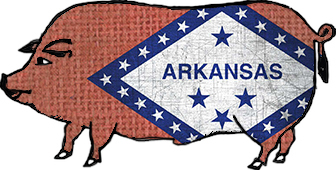I spent my afternoon today as one of the judges at the Arkansas Times Heritage Hog Roast. That’s a local Arkansas barbecue competition that uses heritage hogs. This year they provided the professional smokers with Boston Heritage Hogs developed and raised by Katie Short of Farm Girl Meats. (The amateur teams each received a pork shoulder from Edwards Meats.) Most of the hogs were in the 120-130 pound range, which was a bit larger than expected. I would guess that just means they were happy from having grown up eating seeds, nuts, blackberry and greenbrier crowns, and organic grain!
The Heritage Hog Roast is a bring your own/make your own cooker event. So some folks backed up their trailers.

Others built their pits out of concrete blocks and corrugated metal. There’s a lot of beauty in a concrete block and corrugated metal smoker.

All the teams used wood–some hickory, some apple, some oak, some cherry, or a combination of them, and some also used lump coal. At least one team built a fire box and made their own coals by burning down wood over time.
It takes time to cook a hog the right way. But after about 15 hours of smoking you can end up with a gorgeous mahogany hog like this one from Grumpys Too.

They got this gorgeous color from a triple mopping of their mojo mop, made of oil and orange zest and lemon zest. They also filled their smoker’s water pan with sliced oranges and lemons.
Lots of team used mops. Here’s the one the guys from the soon-to-be-opened Vault in Hot Springs were using. Full of secrets, they said.

The goal of course is to end up with a juicy juicy beast. Here’s a video of the juice beast made by the joint team Flyway Brewing/Count Porkula.
But sometimes, looking good is as important as tasting good. Grumpys Too took the time to fully dress their hog with an orange in its mouth and eyes made from green apple, which the chef carved into eyeballs with a melon baller. Take another look at that gorgeous skin!

The hogs all looked really delicious, and we were really looking forward to digging in. Here’s a preview of how things looked about an hour away from turn in.



As it got closer to turn in, each of the teams spent valuable time picking just what they were going to serve the judges. We didn’t get to see much of this next part (or see what each team put in their turn in boxes) since we were ushered away to our judging station, but here are a few photos of some of the teams starting to pick out their best cuts.







When turning in a whole hog box, it is important to provide a variety of cuts. Also important is to provide some crispy cracklings! That way your turn in box has variety, contrast and texture. Each of us judges was really looking forward to cracklings.

So now it came time for judging. I’ll give a more in depth post on the judging process, but there are some hard and fast rules: only put your best in the box, make it full, make it pretty, and if you can, provide a variety. The best teams here did just that.
Here’s each of the professional boxes at turn in, in the order that they were turned in. Try and pick out which one has the best appearance. That’s the first criteria we look to when judging barbecue. (The others are taste, tenderness and the overall impression.)







Did you see a favorite? Here is the turn in box of the winning team, Flyway Brewery/Count Porkula.

They had five different cuts represented here, ribs, shoulder, tenderloin, ham and crispy skin. So that you can see all the variety, here’s how I laid out the selection of their box when I judged it.

And here’s the professional team Flyway Brewing/Count Porkula after the win.

The amateur teams had a good day too. They had a more liberal approach to their turn in boxes and were allowed to put in sides as well. Here are their boxes, this time with the winner first.



We judged each of these boxes blind, and had great barbecue all around. All the teams should be very proud of the work they put into this. We were really pleased with the overall quality of the boxes and how well they scored on appearance, taste, tenderness and overall impression, and are really looking forward to seeing everyone again next year.
My next post will walk through judging this competition, so you can get an idea of what judges look for, and how to better position your team for a win in any whole hog contest.

Leave a Reply